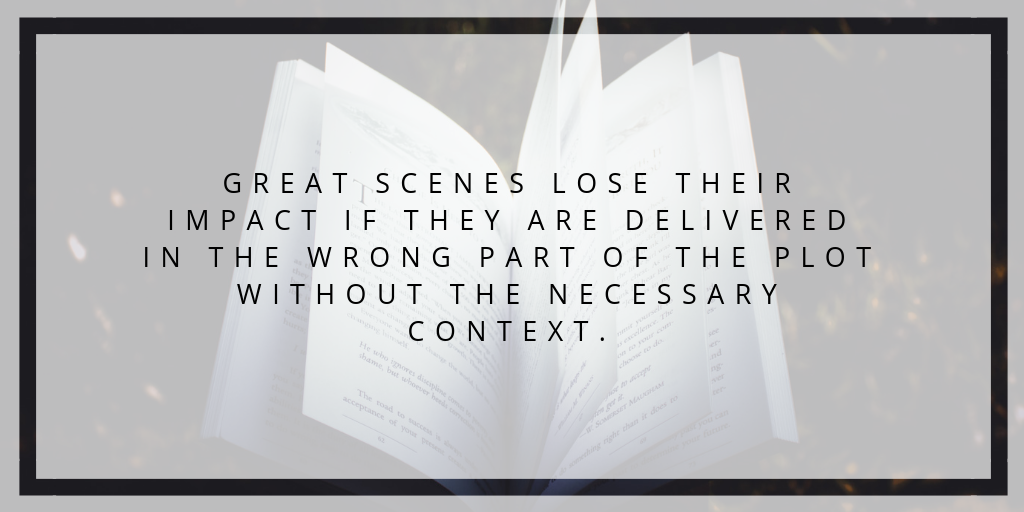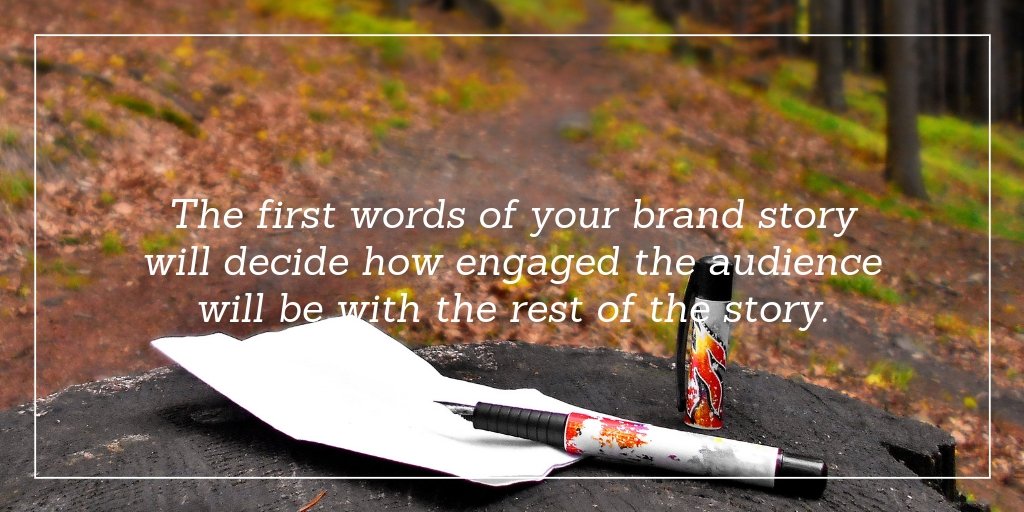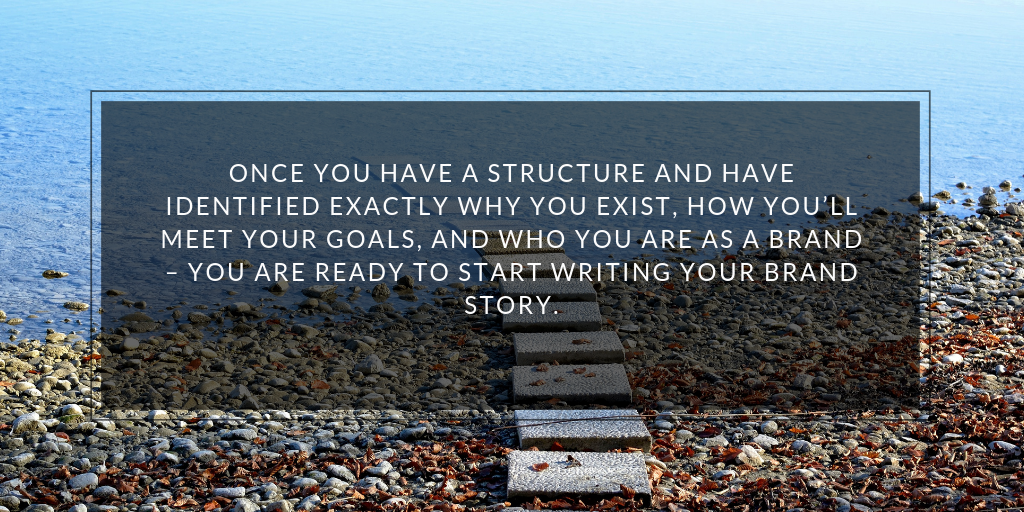Behind every business is a story, but knowing how to create a brand story that sells can be challenging for entrepreneurs. In his popular TED Talk, Simon Sinek constantly mentions, “People don’t buy what you do – they buy why you do it.” And he’s not wrong.
In many studies, research has shown that customers don’t use logic to buy products and services. Rather, emotions are the primary influence on a customer’s purchasing decision.
If there’s anything you can learn from the film industry – nothing evokes powerful emotions inside of a person more effectively than a great story. This is also supported by science. When we are captivated by a story, our brains release chemicals called cortisol and oxytocin – the former which helps our brain focus more on the story and the latter which produces ‘feel-good’ emotions inside us. That’s great and all, but how does this help your business or company? According to Harvard Business Review, here’s how:
‘With both oxytocin and cortisol in play, those who had the higher amounts of oxytocin were much more likely to give money to someone they’d never met.’
Great marketers are aware of this, and as a result, they use great stories in their advertising to promote their brands, attract more customers, and make more sales. However, just having a brand story isn’t enough. You need a great one. In this post, we’ll give you the tips you need to bring your brand story to life.
The 3 Elements of a Great Brand Story
Creating an awesome brand story for your company isn’t rocket science, but there is a formula to it. Let’s take a look at the three most important factors of an effective brand story.
The First Element of A Great Brand Story: The Plot
In every story, there is a plot; or, a structured format of each major event that takes place in the story. Just like a novel or a movie, the structure of your plot is more important than anything else. Even great scenes lose their impact if they are delivered in the wrong part of the plot without the necessary context.
At its core, the job of a brand story is to tell consumers why your company exists, and clarify the value it brings to the consumer, the industry, or hey, even the world (you have to think big sometimes).
Unfortunately, most companies don’t do this. Rather, they squander the opportunity to connect and instead, simply state who they are and what they do. Their story becomes a one-sided “me, me, me” story, without considering the needs and demands of the consumer. Since these types of brand stories are so common, they fail to resonate with the intended audience – and thus, they never motivate even a single person to make a purchase.
Professor Paul J. Zak, an American Neuroeconomist that helps companies and organizations understand consumer behavior, explains why this is the case:
“… people are substantially more motivated by their organization’s transcendent purpose (how it improves lives) than by its transactional purpose (how it sells goods and services). Transcendent purpose is effectively communicated through stories – for example, by describing the pitiable situations of actual, named customers and how their problems were solved by your efforts.”
What this means is, in your brand story, customers care less about who you are and what you make, and more about how you can improve their lives or immediate situation.
When deciding how you will structure your story, consider the why, how, and who.
Begin your brand story with the ‘why’
You only get one chance to make a great first impression, and the first words of your brand story will decide how engaged the audience will be with the rest of the story. Start setting up your brand story by identifying your organization’s ‘why’; or, the reason why your company exists.
Why is this important? Think back to Apple when it launched the first iPod. At the time of launch, no one really knew what an MP3 player was. Claiming that you had the greatest MP3 player had no impact; because no one even knew why they needed an MP3 player.
When Steve Jobs announced the launch of the iPod it back in 2001 at the Apple Music Event, he emphasized the why. No one wanted to hear about the technical makeup of an MP3 or the inner workings of the device. The way he presented the product and brand centered on one thing – the ability to have “a thousand songs in your pocket.”
Only after emphasizing on the “why” did he move towards showing how it works and what the device actually was. Did it work? Well, by 2007 (when the iPod Touch debuted), Apple had already sold over 100 million iPods… So yes, I’d say it worked.
Follow up your brand story with the ‘how’
Defining the purpose within the brand story is critical, but it’s not the only important part of the story. In addition to showing why you exist and what value you bring, you must also explain how you will deliver on your brand promises. Nobody likes empty promises. Before you prepare your brand story, consider the actions that your company will take to meet the claims you’ve made.
Look at how Nike follows up their promise with a commitment to action. In their mission statement, they state that their ‘why’ is ‘To bring inspiration and innovation to every athlete in the world.’
But they know this isn’t enough. A goal without a plan is just a pipe dream. That’s why, just after the why in their brand story, they follow up with the how:
‘We do that by creating groundbreaking sport innovations, by making our products more sustainably, by building a creative and diverse global team and by making a positive impact in communities where we live and work.’
So, how does your company deliver? What kind of services and products do they create to move forward with its mission? How is it’s culture represented? In other words, how does it fulfill its purpose? Before you begin penning your story, make sure you can answer these questions.
End your brand story with the ‘who’
Now that you know why your company needs to exist and the activities required to meet your objectives; you can add the ‘who’ into your brand story structure.
Identify the reasons that your brand is the right company for solving the specific problem that you seek to resolve. Write down your competitive advantage, your unique selling proposition, and the specific reasons why your team is the right team for the challenge.
Detail what your company is all about, what products/services you offer, where you’re located, how long you’ve been in existence – and other important details.
Once you have a structure and have identified exactly why you exist, how you’ll meet your goals, and who you are as a brand – you are ready to start writing your brand story.
The Second Element of A Great Brand Story: The Content
The purpose of a brand story is to make sure your brand is remembered. However, knowing how to create a brand story that is memorable and inspires consumers to act; well, that’s quite a bit more difficult.
Here’s what Professor Paul J. Zak recommends:
“When you want to motivate, persuade, or be remembered, start with a story of human struggle and eventual triumph. It will capture people’s hearts – by first attracting their brains.”
What he means is, people connect with the ‘rags to riches’ story. People relate to the struggle and are inspired by one’s ability for one to overcome it.
Developing your storyline in this fashion is simple, but it requires two main qualities: tension and release.
Build tension by highlighting the problem
In any story, a problem or challenge exists, and your brand story is no different. Lead it with tension by showcasing a problem that a specific customer faced. To effectively create the right amount of tension, focus your brand story on one specific problem – and one that is relatable to each consumer within your target audience.
Once you’ve connected your audience to the issue at hand by building tension, they will be engaged and curious to find out how that issue can be solved (the release).
Release tension by highlighting the solution
Your consumer is engaged. You’ve told them, “Look, this client had a major problem and you’re facing this same problem.” They realize that they have a huge challenge in front of them, and they want a solution. If this has been accomplished, you are in a perfect position.
Describe how the customer’s problem was resolved, how their anxiety about their challenge was eliminated, and how resolving the issue changed their life for the better.
Remember, there is a purpose to having a brand story. You want your story to resonate and connect with consumers, and the tension/release model is the best way of accomplishing this. Doing so allows you to create drama in your brand story, which will make it more influential, captivating and inspiring.
Without such a drama, your audience won’t know why your brand story matters; or really, why you or your business matters. Without something to strive for, to fix, to solve – why does your business exist? If you want to create a great brand story, connect them to the problem and calm their fears with a solution.
Keep the story simple
Knowing how to create a brand story also means knowing how to balance the drama of the story with simplicity.
Complicated stories are difficult to navigate, which means people won’t understand the message you’re trying to convey. They’ll forget who you are and what value you bring to the table. The opportunity to connect with them will have been missed, and your one chance to persuade them will have been ruined. In any type of brand story or message, simplicity is key.
Nielsen and Norman Group stated in their research:
“Good communication has strong business value. Organizations with clear writing styles are perceived to possess greater transparency and credibility than companies that don’t. Plain language removes barriers between you and your readers. It sets your organization apart from the competition, resulting in increased conversions and loyalty.”
Try using as many simple words as possible for universal understanding, and stay away from technical terms that only an expert (like yourself) would understand. As Neilson and Norman stated: “no one has ever complained that a text was too easy to understand.”
The Third Crucial Element of A Brand Story: The BHAG
What’s a BHAG, you might wonder?
A BHAG is an abbreviation for ‘big, hairy, audacious goal’. James Collins and Jerry Porras created, coined and explored this term in their popular business book “Built to Last: Successful Habits of Visionary Companies”.
The purpose of a BHAG is to give a company a direction for their next 30-40 years. It is a goal so big that most people outside the company will regard it as near-impossible to achieve, but in fact, has a small probability of being realized by the company.
In the case of your brand story, the BHAG will define your company’s long-term objective; setting the stage for you to briefly describe your short and mid-term plans.
To give you an idea, here are some examples of popular BHAGs by companies:
- Microsoft: A computer on every desk and in every home.
- SpaceX: To create the first human settlement on Mars.
- Google: To organize the world’s information and make it universally accessible.
Your BHAG will serve as the overarching theme for your brand – and will give better context when you tell your brand story.
How To Promote Your Brand Story
Congrats, you’ve successfully constructed your brand story! Now it’s time to share it with the world. The whole point of writing a brand story is to get your story in front of consumers, and that will take a bit of marketing. In this section, we will lay out four effective ways to promote your brand story.
1. On social media channels
Social media platforms are the perfect place to share your brand story. Users want to share things that are meaningful to them, and if you’re able to connect the right way, it could lead to free viral promotion. Produce a variety of content to tell your brand story – pictures, videos, blog content, and etc.; and post it to the most related platforms.
2. Using your own personal network
If you are someone who already shares valuable content (in some way, shape or form) and have amassed a loyal following of either email subscribers or social media followers; share your story with them first. Since they are loyal to you already, they will be most interested in your story and most likely to share. If you don’t have a network already, try to align with someone who does – whether it be a non-competitive partner, an influencer or the media/press.
3. Inspire your customers to share your brand story on your behalf
If your company creates high-quality products, has an inspiring brand story behind it and markets that story aggressively using the strategies outlined above, you’ll find it much easier to generate brand awareness.
Executed properly, your loyal customers will also start promoting your brand story for you. They’ll write content about you, leave reviews and ratings, share/link to your content, and tell their friends about you.
In addition to amassing loyal followers, your brand will become more credible, more trustworthy and more popular. All thanks to creating a great brand story.
As Harrison Monarth, the author of the New York Times bestselling book ‘The Confident Speaker’ says:
“A story can go where quantitative analysis is denied admission: our hearts. Data can persuade people, but it doesn’t inspire them to act; to do that, you need to wrap your vision in a story that fires the imagination and stirs the soul.”
Three Examples of Great Brand Stories
Great brand stories aren’t just limited to the big players. Even small companies have the opportunity to access the power of great brand stories and propel their businesses to the next level.
In this section, we’ll show you three companies, varying in size, who have successfully created interesting brand stories and used them to grow their business.
ConvertKit
ConvertKit is an email marketing company founded by Nathan Barry. It has an excellent brand story that shows how even a small one-man company can leverage the power of storytelling to build their brand. Let’s break down ConvertKit’s brand story using the three elements we discussed above.
1. Structure
ConvertKit’s brand story is a great example of the concepts we’ve covered. You can read the whole thing on their own website, but here’s the short version of it:
- The Why: ConvertKit’s reason is crystal clear: they exist to help creators make a living online.
- The How: By teaching creators everything they know – creating something every day, focusing on taking care of existing customers more than winning new ones, working in public, being generous, doing less with higher efficiency and hiring productively.
- The Who: They are a SaaS startup that builds a world-class email marketing service for creators.
2. Story
ConvertKit’s story is the story of its founder, Nathan Barry.
Nathan Barry was – and is a creator just like his company’s customers are. His story is that he publicly challenged himself to build a ‘side project’ that would generate $5,000 in monthly revenue. This side-project, he named ConvertKit.
Since he was a creator himself, he was aware of what other creators would need from an email marketing tool – so he went on to build the ultimate solution.
Building Tension:
He identified that tools like MailChimp are easy to use, but lack powerful features; while tools like Infusionsoft are powerful, but extremely complex and difficult to operate for the average user.
Providing Release:
As a solution, he built ConvertKit, a tool that’s easy to use like MailChimp, and powerful like Infusionsoft. The perfect balance for creators that need maximum effect with minimum effort.
3. BHAG
ConvertKit has actually divided their BHAG into five parts:
- Help creators make 1 billion dollars online.
- Get 250,000 creators to use ConvertKit.
- Make $100 million in annual revenue.
- Be 100% remote with 50 teams or fewer.
- Remain 100% independent.
As you can see, their brand story is aligned around their BHAGs – and vice versa.
To date, they have been highly successful. The story of ConvertKit and it’s creator Nathan Barry has received an enormous amount of word-of-mouth and their email marketing tool has grown to become one of the best in the market.
Zappos
Zappos is an online shoe retailer based in Las Vegas. It was one of the early ‘.com’ companies and was started in 1999 by Nick Swinmurn. In 2009, Zappos was acquired by Amazon for $1.2 billion. Their brand story has propelled them to become one of the most lovable companies in the U.S.A.
1. Structure
Zappos’ brand story might not be immediately apparent in their marketing, but when you do business with them, you know exactly who they are, what they do and why.
- The Why: It is difficult to find high quality shoes online, and even more difficult to find an online shoe company that offers a high level of customer support.
- The How: They offer a wide variety of shoes in all shapes, sizes, widths and colors. Moreover, their support staff and delivery services are one of the best in the world. One of their biggest competitive advantages is a no-questions asked product return policy.
- The Who: Zappos is one of the world’s most trusted and reliable online destinations for quality shoes and footwear.
2. Story
Zappos’ story resonates with people of all kinds, because it is so familiar.
Building Tension:
It all started in the 90s when Nick Swinmurn, the founder of Zappos, went shopping for shoes at a mall. Unfortunately, none of the stores provided the exact shoes he wanted. He decided to search online, but given that the internet wasn’t then what it is today, no one offered shoes with the level of quality that the mall stores were offering.
Providing Release:
Nick Swinmurn committed to providing a great online shoe shopping experience, and launches with his own website, shoesite.com. He wanted to make sure the quality was the same as the branded stores that customers would visit inside a mall. Zappos was born. For those who want quality shoes, a convenient shopping experience, and unparalleled support; Zappos is the solution.
3. BHAG
Zappo’s BHAG is to become ‘the best place for customer service in the world’. This means, out of the millions of companies in the world, Zappos wants to be the leader in serving customers properly and effectively.
Have they been successful? Looks like it.
According to Inc.com, 70% of Zappos’ business comes from repeat customers – and in their own words: ‘managers from other companies–including many from service and quality leaders like Southwest and Toyota–make regular pilgrimages to Zappos facilities to learn how the company pulls it off.’
Dollar Shave Club
Dollar Shave Club is an online subscription platform that delivers razor blades and other cosmetic products specifically to a male audience. It shocked the world when this tiny startup, started by improv comedian Michael Dublin, sold for $1 billion to Unilever.
Was it their blades? No, Gillette had better blades. Was it their customer service? Probably. Was it their brand story? Definitely.
1. Structure
Dollar Shave Club’s brand model is simple. Nothing complicated. They’re just here to sell razors, but they were able to do it with two major advantages: price and convenience. These factors drove their brand story, which fueled their success.
- The Why: For men, purchasing razors is an inconvenient experience. High markup makes razors expensive to purchase, and men must travel to the convenience store to purchase them.
- The How: They provide high-quality razors for $1/month, delivered directly to the customer’s doorstep, on schedule, and with little to no effort.
- The Who: They are a first-of-kind razor subscription company with a new business model and a hilarious founder that produces awesome comedic brand content.
2. Story
The Dollar Shave Club’s story is the story of all men.
Building Tension:
Michael Dublin, the founder of the Dollar Shave Club urges people to stop ‘paying for high tech razors you don’t need’. The brand story details how razors are extremely overpriced, although they are cheap to produce. While the brand story was presented humorously, it brought many issues to light – such as how men need the assistance of an attendant to open up the razor case at the convenience store – as if they are storing gold and diamonds!
Providing Release:
For a far lower cost – Dollar Shave Club will deliver high-quality razors to your doorstep. There are no extra fees. You can cancel your membership anytime, and they have a no-questions-asked, money back guarantee.
While their story is simple, it is extremely effective. Before you create your strategy, check out Dollar Shave Club’s YouTube videos to see how they were able to combine their brand story with comedy to drive new interest in their business model.
3. The BHAG
The Dollar Shave Club’s big, hairy audacious goal is ‘to make sure you always have everything you need to look, feel, and smell your best.’
By this it means they want every man to have the best sanitary and cosmetic products they need at an affordable price, on their doorstep, each and every month. That’s their BHAG, simple and plain – but is worth billions if even halfway achieved.
And yes, the way DSC promoted their brand story is the prime definition of perfection. In the 48 hours since Michael Dublin released his viral ad for showcasing the Dollar Shave Club’s brand story, they received 12,000 orders. Now several years later, Dollar Shave Club is valued as a multi-billion dollar company. The power of a great brand story is infinite.
Your Brand, Your Story
Now you know exactly how to create a brand story that stands out, but it’s up to you to actually bring life to your story. Be honest, be enthusiastic, and mostly, be relatable to your target audience.
If you’re ready to take your business to the next level, we can help. Our business plan consultants know exactly what it takes to develop a brand story and use that story to attract both consumers and investors. Ready to write your business plan and add success to your brand story? Contact us today!

















